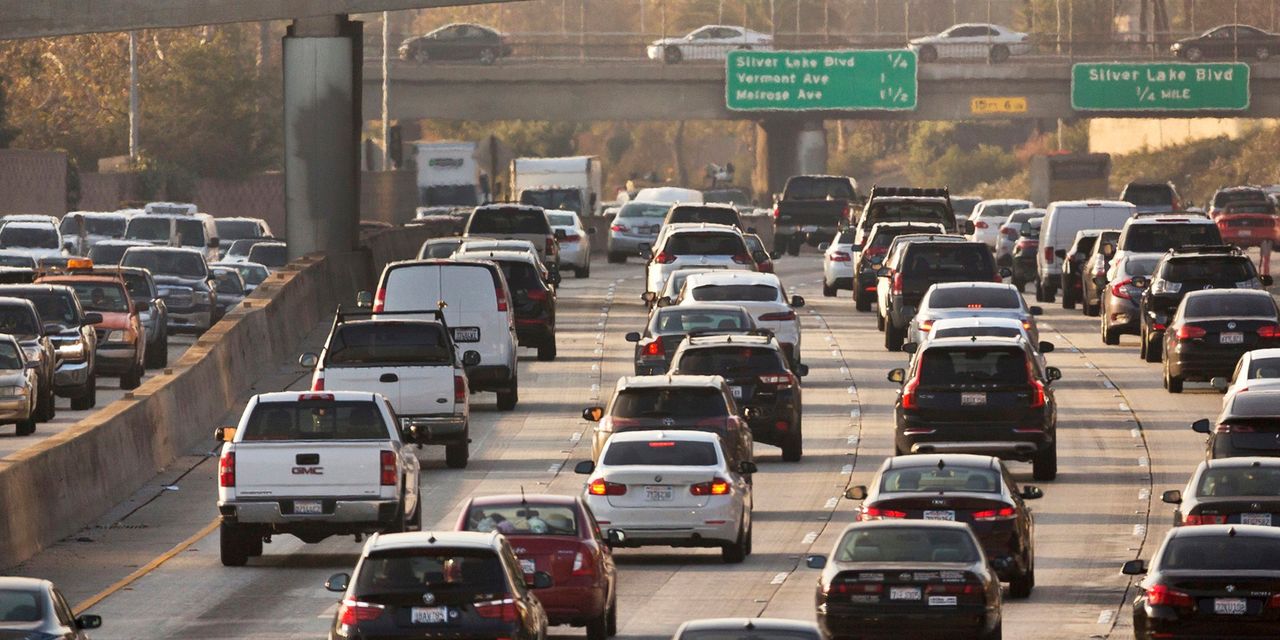
They are a jalopy badly in need of repairs, but America’s fuel-economy rules have been rolling along since 1975, burning more oil and spewing more pollution than their builders intended. Still, when it comes to one of the few roadworthy policies available, a tuneup makes more sense than a trip to the scrap heap.
Many economists will tell you that higher gas taxes make more sense than forcing car makers to sell more efficient vehicles, and they are right. Politics is the art of the possible, though. Last month, the Biden administration tightened up the Corporate Average Fuel Economy standards that the Trump administration had loosened. Unfortunately, CAFE’s design flaws remain: Auto makers selling larger cars face less stringent targets than those selling smaller ones. That difference is generally even wider between passenger cars and light trucks—a category that actually includes larger crossovers and some SUVs, such as the Toyota Rav4, Nissan Rogue and Ford Escape. The discrepancy mattered less in the 1970s when most people drove normal passenger cars.
Economists point out that the size-based feature gives car companies an incentive to manufacture and sell bigger vehicles: to make fuel economy standards easier to meet. There is no clear mechanism in the rule that works to limit the number of gas guzzlers an auto maker sells. There also are several loopholes, such as credit given for technologies that don’t directly improve fuel economy.
“The real-world stringency of footprint-based CAFE standards is by far the most important thing the market doesn’t understand about future oil demand,” says Bob McNally, president of consulting firm Rapidan Energy Group. “I’m shocked it has persisted this long.”
The numbers speak for themselves. Even as standards have tightened over time, the actual sales-adjusted fuel economy rating of new vehicles has been unchanged at around 25 miles per gallon since 2014. That was the year Saudi Arabia and others flooded the oil market to gain market share against U.S. shale.
No wonder U.S. vehicles are among the least efficient globally: The average fuel consumption of newly sold U.S. light-duty vehicles, which include passenger cars and light trucks, exceeds the world’s average by 21% and Europe’s by 46%, according to the International Energy Agency. CAFE hasn’t bent the curve in absolute terms either. Carbon dioxide emissions from motor gasoline (excluding ethanol) were 23% higher in 2019 than in 1980 and the U.S. transportation sector’s motor gasoline consumption has risen by 39% over the same period, according to the U.S. Energy Information Administration.
That makes the EPA’s bold 2026 model year goal—55 miles per gallon based on lab tests and 40 based on how people really drive—look iffy. It depends on gas prices and what vehicles people prefer. Detroit certainly won’t be hiring the EPA’s forecasters. Back in 2012, the agency expected about a third of U.S. new vehicle sales in 2020 to come from the sale of light trucks. They actually accounted for more than half.
The EPA says final standards for model years 2023 to 2026 can be reached with a “growing percentage of electrified vehicles,” projecting that electric vehicles and plug-in hybrids will account for 17% of cars manufactured in 2026. That is up from less than 3% of U.S. light-duty vehicle sales in 2021. That seems ambitious.
The rules have evolved over time to close some loopholes that previously reduced compliance costs without boosting gas mileage. For example, EVs were often double-counted and so-called flex-fuel vehicles able to use more ethanol were treated as if their drivers regularly used high-ethanol fuels, giving gas guzzlers stellar mileage on paper. Those flex-fuel vehicles rarely operated on high-ethanol blends and offered no improvement in real-world efficiency, according to a 2017 policy paper by Prof. Michael Greenstone at the University of Chicago, Prof. Cass Sunstein at Harvard and Sam Ori, executive director at the Energy Policy Institute at the University of Chicago.
Taxing carbon emissions or gasoline directly, as Europe does, would be far more cost-efficient. An analysis by Prof. Mark Jacobsen at the University of California, San Diego, showed that the cost per gallon saved through the fuel-economy standard is three to six times higher than a gasoline tax. But raising federal gasoline taxes, which have stayed at an inflation-unadjusted 18.4 cents a gallon since 1993, would be political suicide. Carbon taxes are deeply unpopular, too.
Instead, economists have come up with some tweaks government agencies might be able to implement within the existing statute. In a policy paper published last year, Prof. Koichiro Ito at the University of Chicago suggested getting rid of the distinction between cars and light trucks, arguing “there is no economic rationale that can justify less stringent economy regulations for SUVs than other passenger cars.” Prof. Ito suggests that the Transportation Department might be able to do this on its own. Messrs. Greenstone, Sunstein and Ori propose a cap-and-trade system that starts with a limit on a vehicle’s lifetime fuel consumption and carbon dioxide emissions from each year’s new vehicle sales, suggesting that the EPA should have broad discretion to do this.
Fuel-economy standards, laments Mr. Ori, “have a deceptive way of being palatable, specifically because car buyers don’t actually see the cost broken out.”
Luckily for government agencies, plenty of research has been done to point out exactly what those costs are and where the holes are located. They can still use the tools they have to tighten the screws and soup up this clunker.
Write to Jinjoo Lee at [email protected]
Copyright ©2022 Dow Jones & Company, Inc. All Rights Reserved. 87990cbe856818d5eddac44c7b1cdeb8







